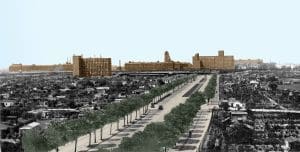Siemens has broken ground on Siemensstadt Square in Berlin, one of Europe’s largest urban development projects that provides a “global blueprint” for regenerating brownfield sites through digital twin and AI technology
Together with numerous project partners, Siemens will create a “district of the future” at the more than 100-year-old industrial site in Berlin’s Spandau area, with an end-to-end digital twin backed with AI from the Siemens Xcelerator platform.
Around 35,000 people will live and work at Siemensstadt Square, which will have an area of roughly 188 acres and floorspace of more than a million square meters.
Living space for up to 7,000 people will cover a total area of 270,000 sq m. Thirty percent of this space will comprise social housing. In addition, numerous companies and partners will create up to 20,000 jobs.
Siemens itself is investing €750m – its largest-ever single investment in Berlin and a strong commitment to Germany as an industrial location. By 2035, total investment in the project will reach up to €4.5bn.

Digital transformation to break down silos
Siemensstadt Square will demonstrate how technologies from the Siemens Xcelerator platform can combine digital and sustainable solutions at all levels of the city, from intelligent sustainable buildings with photovoltaic roofs to AI-optimized biodiversity monitoring and solutions for electric vehicles.
At the heart of the planning, optimization and operation of the urban infrastructure is an end-to-end digital twin, which consolidates all datapoints from a campus twin, a building twin and an energy twin.
Through the intelligent connection and utilization of this data, a complete virtual image of the district is created, breaking down data silos.
As a result, errors can be detected in the digital city and avoided in the real world. Potential for improvement can be continuously identified in the digital world and implemented, so that even visionary concepts can be tested and a livable future actively shaped.
The campus twin, which was developed in collaboration with Bentley Systems, acts as a digital real-time masterplan and brings together all relevant data – everything from building information to planning status.
The building twin is used to carry out the photorealistic replanning of the existing area.
Siemensstadt Square is “customer zero” for this project. Industrial buildings more than 100 years old and with an area of around 250,000 sq m have already been integrated into a “walk-in” twin without interrupting their ongoing operation.
To optimize the district’s power supply, the energy twin is used to generate forecasts in the virtual world and to monitor supply variants. With the help of data analysis, integrated AI optimizes energy efficiency, traffic and waste management and enables forecasting.
A new sustainable neighborhood for Berlin
The project’s energy design shows how established cities can reduce their carbon emissions.
In collaboration with Berliner Wasserbetriebe – Berlin’s water supply and wastewater disposal utility – and an energy supplier, Europe’s largest wastewater heat exchanger will be installed at the location.
While the district currently emits around 3,000 tonnes of CO2 a year – an amount equivalent to the annual emissions of 2,100 cars with internal combustion engines – the system will combine with heat pumps to start supplying the district with 100% carbon-neutral heating and cooling in 2026.
The electricity required for the system will be generated entirely from renewable and local energy sources. And all of this will be achieved with significantly more residents and a higher productivity level.
The groundbreaking ceremony at German Chancellor Olaf Scholz and the governing mayor of Berlin, Kai Wegner.
“This laying of the foundation stone is encouraging. Because it shows what we can already achieve in Germany today – in urban planning and in the construction of modern neighborhoods,” Chancellor Scholz said.
“Siemensstadt will remain what it has been for 125 years – a place of new beginnings, a place of the future and of confidence.”
Roland Busch, president and CEO of Siemens, said: “Siemensstadt Square will be the blueprint for the city of the future. The project will combine artificial intelligence, digital twins and other technologies from the Siemens Xcelerator platform to transform an industrial brownfield area into an engine for solid, healthy growth.
“Net zero will be ensured through automated production and building technology, optimized energy management and green mobility. It will be a blueprint for sustainable growth and competitiveness through digitalization.”

